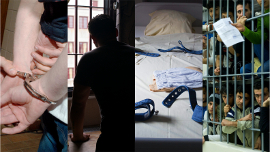In the prisons sector, the CPT examined once again the question of overcrowding affecting the Belgian prison system (and, in particular, the situation in Jamioulx prison where the level of occupancy reached 150%). In this regard, the CPT took note of the “2008-2012 Master Plan for a more humane prison infrastructure” and of the application of an altogether novel solution, the fixed-term rental of cell space located in a neighbouring country (in this case, Tilburg prison in the Netherlands). As to the questions relating to the prison staff strike, the CPT again called upon the Belgian authorities, as it had already done after the visit in 2005, to introduce, without further delay, a “guaranteed service” for prisoners. The very serious ill-treatment allegedly committed by police officers standing in for the prison staff in a Brussels prison in September and October 2009 once again reinforces the need to find a lasting solution to this question. Regarding the prison units subject to special security measures (“Quartiers des mesures de sécurité particulières individuelles” – QMSPI), the Committee stressed the importance of strict compliance with the selection criteria for detainees assigned to these units, which are not intended to be maximum security units (“Quartiers à Sécurité Renforcée” – QSR). The CPT also took note of the changes made to the layout of the psychiatric annexe of Lantin prison, and recommended that the Belgian authorities make similar changes in the psychiatric annexe of Jamioulx prison. It also took note of the reinforcement of the medical and psychiatric teams, and stressed the need for still greater efforts in this regard. At a more general level, the CPT stressed the need for all provisions of the “Loi de Principes” (Prison Principles Act) to be brought into force quickly, as the non-application of certain of its chapters was causing legal uncertainty, particularly as regards disciplinary sanctions.
As regards the police, the CPT took note of the small number of advances made in respect of fundamental safeguards given to persons placed under administrative arrest. The Committee also noted the adoption of two Royal Decrees, one governing the physical conditions in police detention cells and the other bringing into force a code of ethics for the police. By contrast, the Committee could only observe the lack of action regarding the implementation of the recommendations made over many years concerning the fundamental safeguards to be offered to persons placed under judicial arrest, and in particular, as regards access to a lawyer while in custody. Furthermore, it made recommendations on the application of special techniques, such as the use of electro-shock weapons (Taser) and the escorting of “level 3” prisoners presumed to be dangerous. Regarding the holding cells in the Portalis Court of Justice Building in Brussels, the Committee recommended that the Belgian authorities carry out a fire safety audit and invited them to consider transferring the holding cells to premises specially designed and equipped for detention purposes.
As a result of worrying information which it received earlier in the year, the attention of the CPT has also been drawn to the “’t Knipoogje” boarding establishment of the “’t Vurstjen” medico-educational institute at Evergem. It has made detailed recommendations concerning this establishment and has also recommended that an ill-treatment prevention plan be drawn up for the all boarding schools in the country and that regular inspections be carried out. The visit to the special admissions department (“Hôpital d’Accueil Spécialisé” – HAS) of the Fond’Roy psychiatric clinic in Uccle has prompted a review of the questions concerning the implementation of the procedures in place for compulsory hospitalisation and a discussion concerning the question of psychiatric treatment without the patient’s consent. The CPT has also made a number of recommendations following its visit to the Centre for Irregular Migrants in Vottem and the INAD Centre at Brussels National Airport.
The CPT's visit report is available on the Committee's website: http://www.cpt.coe.int



